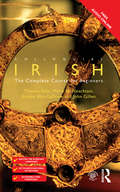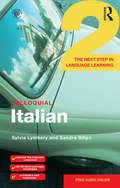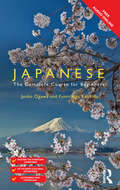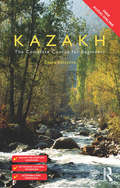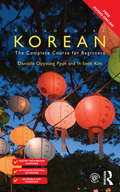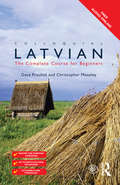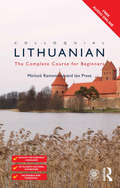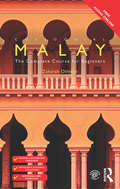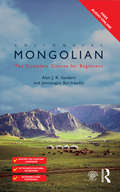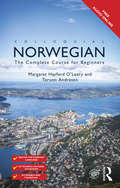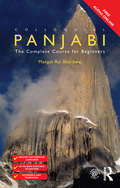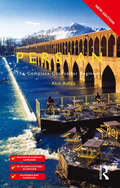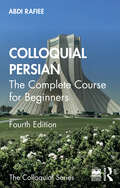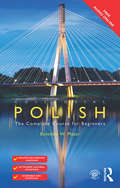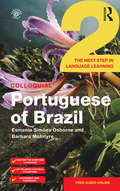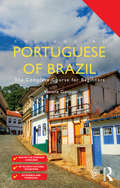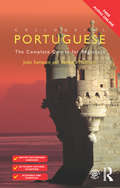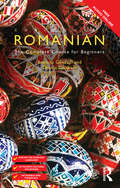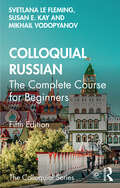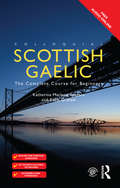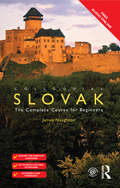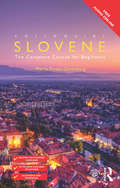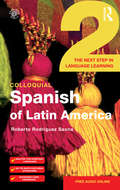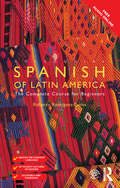- Table View
- List View
Colloquial Irish: The Complete Course for Beginners (Colloquial Ser.)
by John Gillen Thomas Ihde Maire Ni Neachtain Roslyn Blyn-LaDrewSpecially written by experienced teachers, this easy to use and completely up-to-date course provides a step-by-step approach to spoken and written Irish with no prior knowledge of the language required. What makes Colloquial Irish your best choice in personal language learning? emphasis on the language of East Connemara, with a clear pronunciation guide and an appendix on dialectal differences within Irish stimulating exercises with lively illustrations effective combination of language points, dialogues and cultural information Irish/English and English/Irish word lists. By the end of this rewarding course you will be able to communicate confidently and effectively in Irish in a broad range of everyday situations. Audio material to accompany the course is available to download free in MP3 format from www.routledge.com/cw/colloquials. Recorded by native speakers, the audio material features the dialogues and texts from the book and will help develop your listening and pronunciation skills.
Colloquial Italian 2: The Next Step in Language Learning (The\colloquial 2 Ser.)
by Sylvia Lymbery Sandra SilipoDo you know Italian already and want to go a stage further? If you're planning a visit to Italy, need to brush up your Italian for work, or are simply doing a course, Colloquial Italian 2 is the ideal way to refresh your knowledge of the language and to extend your skills. Colloquial Italian 2 is designed to help those involved in self-study; structured to give you the opportunity to listen to and read lots of modern, everyday Italian, it has also been developed to work systematically on reinforcing and extending your grasp of Italian grammar and vocabulary. Key features of Colloquial Italian 2 include: Revision material to help consolidate and build up your basics A wided range of contemporary authentic documents, both written and audio Lots of spoken and written exercises in each unit Highlighted key structures and phrases, a Grammar reference and detailed answer keys A broad range of situations, focusing on day to day life in Italy. Audio material to accompany the course is available to download free in MP3 format from www.routledge.com/cw/colloquials. Recorded by native speakers, the audio material features the dialogues and texts from the book and will help develop your listening and pronunciation skills.
Colloquial Japanese: The Complete Course for Beginners (Colloquial Series)
by Junko Ogawa Fumitsugu EnokidaColloquial Japanese provides a step-by-step course in Japanese as it is written and spoken today. This new edition has been completely rewritten by experienced teachers; it combines an accessible approach with a thorough treatment of the language, equipping learners with the essential skills needed to communicate confidently and effectively in Japanese in a broad range of situations. No prior knowledge of the language is required. Key features include: progressive coverage of speaking, listening, reading and writing skills jargon-free explanations of grammar, with key structures presented through user-friendly diagrams Coverage of the different writing systems of Japanese: hiragana, katakana and kanji an extensive range of focused and stimulating exercises realistic and entertaining dialogues covering a broad variety of scenarios useful vocabulary lists throughout the text additional resources available at the back of the book, including a full answer key, a grammar summary, a verb/adjective list with conjugation aid, bilingual glossaries and English translations of dialogues Balanced, comprehensive and rewarding, Colloquial Japanese will be an indispensable resource both for independent learners and for students taking courses in Japanese. Audio material to accompany the course is available to download free in MP3 format from www.routledge.com/cw/colloquials. Recorded by native speakers, the audio material features the dialogues and texts from the book and will help develop your listening and pronunciation skills. Supplementary exercise sheets for hiragana, katakana and kanji and two additional units can also be found here. These additonal units cover more advanced features of Japanese and incorporate a wide assortment of supporting exercises. By the end of this course, you will be at Level B1 of the Common European Framework for Languages and at the Intermediate-Mid on the ACTFL proficiency scales.
Colloquial Kazakh: The Complete Course For Beginners (Colloquial Ser.)
by Zaure BatayevaColloquial Kazakh provides a step-by-step course in Kazakh as it is written and spoken today. Combining a user-friendly approach with a thorough treatment of the language, it equips learners with the essential skills needed to communicate confidently and effectively in Kazakh in a broad range of situations. No prior knowledge of the language is required. Key features include: progressive coverage of speaking, listening, reading and writing skills structured, jargon-free explanations of grammar an extensive range of focused and stimulating exercises realistic and entertaining dialogues covering a broad variety of scenarios useful vocabulary lists throughout the text an overview of the sounds and alphabet of Kazakh additional resources available at the back of the book, including a full answer key, a grammar summary, bilingual glossaries and English translations of dialogues. Balanced, comprehensive and rewarding, Colloquial Kazakh will be an indispensable resource both for independent learners and for students taking courses in Kazakh. Audio material to accompany the course is available to download free in MP3 format from www.routledge.com/cw/colloquials. Recorded by native speakers, the audio material features the dialogues and texts from the book and will help develop your listening and pronunciation skills.
Colloquial Korean: The Complete Course for Beginners (Colloquial Ser.)
by Danielle Ooyoung Pyun Inseok KimColloquial Korean provides a step-by-step course in Korean as it is written and spoken today. Combining a user-friendly approach with a thorough treatment of the language, it equips learners with the essential skills needed to communicate confidently and effectively in Korean in a broad range of situations. No prior knowledge of the language is required. Key features include: • progressive coverage of speaking, listening, reading and writing skills • structured, jargon-free explanations of grammar • an extensive range of focused and stimulating exercises • realistic and entertaining dialogues covering a broad variety of scenarios • useful vocabulary lists throughout the text • additional resources available at the back of the book, including a full answer key, a grammar summary and bilingual glossaries Balanced, comprehensive and rewarding, Colloquial Korean will be an indispensable resource both for independent learners and students taking courses in Korean. Audio material to accompany the course is available to download free in MP3 format from www.routledge.com/cw/colloquials. Recorded by native speakers, the audio material features the dialogues and texts from the book and will help develop your listening and pronunciation skills.
Colloquial Latvian: The Complete Course for Beginners (Colloquial Ser.)
by Christopher Moseley Dace PrauliņšThis new edition of Colloquial Latvian has been completely rewritten to make learning Latvian easier and more enjoyable than ever before! Specially written by experienced teachers for self-study or class use, the course offers a step-by-step approach to written and spoken Latvian. No prior knowledge of the language is required. What makes Colloquial Latvian your best choice in personal language learning? interactive – lots of exercises for regular practice clear – concise grammar notes practical – useful vocabulary and pronunciation guide complete – including answer key and reference section. By the end of this rewarding course, you will be able to communicate confidently and effectively in Latvian in a broad range of everyday situations. Audio material to accompany the course is available to download free in MP3 format from www.routledge.com/cw/colloquials. Recorded by native speakers, the audio material features the dialogues and texts from the book and will help develop your listening and pronunciation skills.
Colloquial Lithuanian: The Complete Course for Beginners (Colloquial Ser.)
by Ian Press Meilutė Ramonienė Meilute RamoniereCOLLOQUIAL LITHUANIAN is easy to use and completely up to date! Specially written by experienced teachers for self-study or class use, the course offers a step-by-step approach to written and spoken Lithuanian. No prior knowledge of the language is required. What makes COLLOQUIAL LITHUANIAN your best choice in personal language learning? Interactive – lots of exercises for regular practice Clear – concise grammar notes Practical – useful vocabulary and pronunciation guide Complete – including answer key and reference section By the end of this rewarding course, you will be able to communicate confidently and effectively in Lithuanian in a broad range of everyday situations. Audio material to accompany the course is available to download free in MP3 format from www.routledge.com/cw/colloquials. Recorded by native speakers, the audio material features the dialogues and texts from the book and will help develop your listening and pronunciation skills.
Colloquial Malay: The Complete Course for Beginners (Colloquial Ser.)
by Zaharah OthmanColloquial Malay: The Complete Course for Beginners has been carefully developed by an experienced teacher to provide a step-by-step course to Malay as it is written and spoken today. Combining a clear, practical and accessible style with a methodical and thorough treatment of the language, it equips learners with the essential skills needed to communicate confidently and effectively in Malay in a broad range of situations. No prior knowledge of the language is required. Colloquial Malay is exceptional; each unit presents a wealth of grammatical points that are reinforced with a wide range of exercises for regular practice. Key features include: A clear, user-friendly format designed to help learners progressively build up their speaking, listening, reading and writing skills Jargon-free, succinct and clearly structured explanations of grammar An extensive range of focused and dynamic supportive exercises Realistic and entertaining dialogues covering a broad variety of narrative situations Helpful cultural points explaining the customs and features of life in Malay-speaking countries. An overview of the sounds of Malay. Balanced, comprehensive and rewarding, Colloquial Malay is an indispensable resource both for independent learners and students taking courses in Malay. Audio material to accompany the course is available to download free in MP3 format from www.routledge.com/cw/colloquials. Recorded by native speakers, the audio material features the dialogues and texts from the book and will help develop your listening and pronunciation skills.
Colloquial Mongolian: The Complete Course for Beginners (Colloquials Ser.)
by Jantsangiyn Bat-Ireedui Alan J SandersColloquial Mongolian is easy to use and completely up to date! Written by experience teachers of the language, Colloquial Mongolian offers a step-by-step approach to written and spoken Mongolian. No previous knowledge of the language is required. Features include: Guide to reading and writing the alphabet Lively dialogues in true-to-life situations Concise grammar explanations A variety of exercises with full answer key, grammar summary, suffix index and two-way glossary Explanatory notes on Mongolian culture and customs By the end of this rewarding course you will be able to communicate confidently and effectively in Mongolian in a broad range of everyday situations. Audio material to accompany the course is available to download free in MP3 format from www.routledge.com/cw/colloquials. Recorded by native speakers, the audio material features the dialogues and texts from the book and will help develop your listening and pronunciation skills.
Colloquial Norwegian: The Complete Course for Beginners (Colloquial Series)
by Margaret Hayford O'Leary Torunn AndresenColloquial Norwegian provides a step-by-step course in Norwegian as it is written and spoken today. Combining a user-friendly approach with a thorough treatment of the language, it equips learners with the essential skills needed to communicate confidently and effectively in Norwegian in a broad range of situations. No prior knowledge of the language is required. Features include: progressive coverage of speaking, listening, reading and writing skills structured, jargon-free explanations of grammar an extensive range of focused and stimulating exercises realistic and entertaining dialogues covering a broad variety of scenarios useful vocabulary lists throughout the text additional resources available at the back of the book, including a full answer key, a grammar summary and bilingual glossaries Balanced, comprehensive and rewarding, Colloquial Norwegian will be an indispensable resource both for independent learners and students taking courses in Norwegian. Colloquials are now supported by FREE AUDIO available online. All audio tracks referenced within the text are free to stream or download from www.routledge.com/cw/colloquials. Recorded by native speakers, the audio compliments the book and will help enhance learners’ listening and speaking skills.
Colloquial Panjabi: The Complete Course for Beginners (Colloquial Ser.)
by Mangat Rai BhardwajColloquial Panjabi: The Complete Course for Beginners has been carefully developed by an experienced teacher to provide a step-by-step course to Panjabi as it is written and spoken today. Combining a clear, practical and accessible style with a methodical and thorough treatment of the language, it equips learners with the essential skills needed to communicate confidently and effectively in Panjabi in a broad range of situations. No prior knowledge of the language is required. Colloquial Panjabi is exceptional; each unit presents a wealth of grammatical points that are reinforced with a wide range of exercises for regular practice. A full answer key, a grammar summary, bilingual glossaries and English translations of dialogues can be found at the back as well as useful vocabulary lists throughout. Key features include: A clear, user-friendly format designed to help learners progressively build up their speaking, listening, reading and writing skills Jargon-free, succinct and clearly structured explanations of grammar An extensive range of focused and dynamic supportive exercises Realistic and entertaining dialogues covering a broad variety of narrative situations Helpful cultural points explaining the customs and features of life in Panjabi-speaking areas. An overview of the sounds of Panjabi Balanced, comprehensive and rewarding, Colloquial Panjabi is an indispensable resource both for independent learners and students taking courses in Panjabi. Audio material to accompany the course is available to download free in MP3 format from www.routledge.com/cw/colloquials. Recorded by native speakers, the audio material features the dialogues and texts from the book and will help develop your listening and pronunciation skills. A wealth of additional text material is also provided on the website. This supplementary material builds on the foundation provided in the Colloquial Panjabi course and will develop your language skills beyond the beginner level into intermediate study.
Colloquial Persian: The Complete Course For Beginners (Colloquial Ser.)
by Abdi RafieeColloquial Persian is easy to use and completely up-to-date! Specially written by an experienced teacher for self-study or class use, the course offers you a step-by-step approach to written and spoken Persian. No prior knowledge of the language is required. What makes this new edition of Colloquial Persian your best choice in personal language learning? Interactive – lots of exercises for regular practice. Clear – concise grammar notes. Practical – useful vocabulary and pronunciation guide. Complete – including answer key and reference section. Whether you’re a business traveller, or about to take up a daring challenge in adventure tourism; you may be studying to teach or even looking forward to a holiday – if you’d like to get up and running with Persian, this rewarding course will take you from complete beginner to confidently putting your language skills to use in a wide range of everyday situations. Audio material to accompany the course is available to download free in MP3 format from www.routledge.com/cw/colloquials. Recorded by native speakers, the audio material features the dialogues and texts from the book and will help develop your listening and pronunciation skills.
Colloquial Persian: The Complete Course for Beginners (Colloquial Ser.)
by Abdi Rafiee Abdi RaifeeColloquial Persian: The Complete Course for Beginners has been carefully developed to provide a step-by-step course to Persian as it is written and spoken today. Combining a clear, practical, and accessible style with a methodical and thorough treatment of the language, it equips learners with the essential skills needed to communicate confidently and effectively in Persian in a broad range of situations. Each unit presents a wealth of grammatical points across different key topics for communicating in Persian. This fourth edition offers thoroughly updated and expanded cultural notes, refined language points offering greater clarity and understanding of the most difficult points, a clearer introduction to the Persian script, and new audio material. Balanced, comprehensive, and rewarding, Colloquial Persian is an indispensable resource both for independent learners and students taking courses in Persian. No prior knowledge of the language is required. Key features include: • A clear, user-friendly format designed to help learners progressively build up their speaking, listening, reading, and writing skills. • Jargon-free, succinct, and clearly structured explanations of grammar. • An extensive range of focused and dynamic supportive exercises. • Realistic and entertaining dialogues covering a broad variety of narrative situations. • Helpful cultural points explaining the customs and features of life in Iran. • An overview of the sounds of Persian. Audio material to accompany the course is available to download free in MP3 format from www.routledge.com/cw/colloquials. The audio material features the dialogues and texts from the book and will help develop your listening and pronunciation skills.
Colloquial Polish: The Complete Course for Beginners
by Bolesław W. MazurColloquial Polish: The Complete Course for Beginners has been carefully developed by an experienced teacher to provide a step-by-step course to Polish as it is written and spoken today. Combining a clear, practical and accessible style with a methodical and thorough treatment of the language, it equips learners with the essential skills needed to communicate confidently and effectively in Polish in a broad range of situations. No prior knowledge of the language is required. Colloquial Polish is exceptional; each unit presents a wealth of grammatical points that are reinforced with a wide range of exercises for regular practice. A full answer key, a grammar summary, bilingual glossaries and English translations of dialogues can be found at the back as well as useful vocabulary lists throughout. Key features include: A clear, user-friendly format designed to help learners progressively build up their speaking, listening, reading and writing skills Jargon-free, succinct and clearly structured explanations of grammar An extensive range of focused and dynamic supportive exercises Realistic and entertaining dialogues covering a broad variety of narrative situations Helpful cultural points explaining the customs and features of life in Poland An overview of the sounds of Polish Balanced, comprehensive and rewarding, Colloquial Polish is an indispensable resource both for independent learners and students taking courses in Polish. Audio material to accompany the course is available to download free in MP3 format from www.routledge.com/cw/colloquials. Recorded by native speakers, the audio material features the dialogues and texts from the book and will help develop your listening and pronunciation skills.
Colloquial Portuguese of Brazil 2: The Next Step In Language Learning (The\colloquial Ser. #10)
by Esmenia Simoes Osborne Barbara McIntyreDo you know Brazilian Portuguese already and want to go a stage further? If you’re planning a visit to Brazil, need to brush up your Brazilian Portuguese for work, or are simply doing a course, Colloquial Portuguese of Brazil 2 is the ideal way to refresh your knowledge of the language and to extend your skills. Key features of Colloquial Portuguese of Brazil 2 include: revision material to help consolidate and build up your basics a wide range of contemporary authentic documents lots of spoken and written exercises in each unit highlighted key structures and phrases, a grammar reference and detailed answer keys a broad range of everyday situations, focusing on Brazil supplementary exercises and Brazilian Portuguese language web-links at www.routledge.com/languages. Audio material to accompany the course is available to download free in MP3 format from www.routledge.com/cw/colloquials. Recorded by native speakers, the audio material features the dialogues and texts from the book and will help develop your listening and pronunciation skills.
Colloquial Portuguese of Brazil: The Complete Course for Beginners (The\colloquial Ser.)
by Viviane GontijoThis new and completely revised edition of Colloquial Portuguese of Brazil provides a step-by-step course in Portuguese as it is written and spoken in Brazil today. Combining a user-friendly approach with a thorough treatment of the language, it equips learners with the essential skills needed to communicate confidently and effectively in Brazilian Portuguese in a broad range of situations. No prior knowledge of the language is required. This edition features: progressive coverage of speaking, listening, reading and writing skills structured, jargon-free explanations of grammar an extensive range of focused and stimulating exercises realistic and entertaining dialogues covering a broad variety of scenarios useful vocabulary lists throughout the text Balanced, comprehensive and rewarding, Colloquial Portuguese of Brazil will be an indispensable resource both for independent learners and students taking courses in Brazilian Portuguese. Colloquials are now supported by FREE AUDIO available online. All audio tracks referenced within the text are free to stream or download from www.routledge.com/cw/colloquials. Recorded by native speakers, the audio complements the book and will help enhance learners’ listening and speaking skills. By the end of this course, you will be at level A1 to A2 of the Common European Framework for Languages and Novice Low to Mid on the ACTFL proficiency scales.
Colloquial Portuguese: The Complete Course for Beginners (Colloquial Ser.)
by Barbara McIntyre Barbara Mcintyre João SampaioColloquial Portuguese: The Complete Course for Beginners has been carefully developed by an experienced teacher to provide a step-by-step course to Portuguese as it is written and spoken today. Combining a clear, practical and accessible style with a methodical and thorough treatment of the language, it equips learners with the essential skills needed to communicate confidently and effectively in Portuguese in a broad range of situations. No prior knowledge of the language is required. Colloquial Portuguese is exceptional; each unit presents a wealth of grammatical points that are reinforced with a wide range of exercises for regular practice. A full answer key, a grammar summary, bilingual glossaries and English translations of dialogues can be found at the back as well as useful vocabulary lists throughout. Key features include: A clear, user-friendly format designed to help learners progressively build up their speaking, listening, reading and writing skills Jargon-free, succinct and clearly structured explanations of grammar An extensive range of focused and dynamic supportive exercises Realistic and entertaining dialogues covering a broad variety of narrative situations Helpful cultural points explaining the customs and features of life in Portugal An overview of the sounds of Portuguese Balanced, comprehensive and rewarding, Colloquial Portuguese is an indispensable resource both for independent learners and students taking courses in Portuguese. Audio material to accompany the course is available to download free in MP3 format from www.routledge.com/cw/colloquials. Recorded by native speakers, the audio material features the dialogues and texts from the book and will help develop your listening and pronunciation skills.
Colloquial Romanian: The Complete Course for Beginners (Colloquial Ser.)
by Dennis Deletant Ramona Gönczöl Ramona Gönczöl-DaviesThis fourth edition of Colloquial Romanian has been completely updated to make learning Romanian easier and more enjoyable than ever before. Written by experienced teachers of Romanian, this course offers a step-by-step approach to spoken and written Romanian. No previous knowledge of the language is required. What makes this new edition of Colloquial Romanian you best choice in language learning? lively dialogues reflecting life in contemporary Romania a range of stimulating exercises with full answer key clear grammar notes and summary extensive English-Romanian and Romanian-English glossaries. Audio material to accompany the course is available to download free in MP3 format from www.routledge.com/cw/colloquials. Recorded by native speakers, the audio material features the dialogues and texts from the book and will help develop your listening and pronunciation skills.
Colloquial Russian: The Complete Course For Beginners
by Susan E. Kay Svetlana le Fleming Mikhail VodopyanovColloquial Russian provides a step-by-step course in Russian as it is written and spoken today. Combining a user-friendly approach with a thorough treatment of the language, it equips learners with the essential skills needed to communicate confidently and effectively in Russian in a broad range of situations, requiring no prior knowledge of the language. Features include: progressive coverage of speaking, listening, reading and writing skills structured, jargon-free explanations of grammar an extensive range of focused and stimulating exercises realistic and entertaining dialogues covering a broad variety of scenarios useful vocabulary lists throughout the text additional resources available at the back of the book, including a full answer key, a grammar summary and bilingual glossaries This fifth edition offers modernised language reflecting social and cultural changes, new vocabulary that's essential for day-to-day interactions, and updated audio material. Balanced, comprehensive and rewarding, Colloquial Russian will be an indispensable resource for both independent learners and students taking courses in Russian. Audio material to accompany the course is available to download for free in MP3 format from www.routledge.com/cw/colloquials. The audio material features the texts, dialogues and exercises from the book and will help develop listening and pronunciation skills.
Colloquial Scottish Gaelic: The Complete Course for Beginners (Colloquial Ser.)
by Katie Graham Katherine M SpadaroColloquial Scottish Gaelic provides a step-by-step course in Scottish Gaelic as it is written and spoken today. Combining a user-friendly approach with a thorough treatment of the language, it equips learners with the essential skills needed to communicate confidently and effectively in Scottish Gaelic in a broad range of situations. No prior knowledge of the language is required. Key features include: progressive coverage of speaking, listening, reading and writing skills structured, jargon-free explanations of grammar an extensive range of focused and stimulating exercises realistic and entertaining dialogues covering a broad variety of scenarios useful vocabulary lists throughout the text an overview of the sounds and alphabet of Scottish Gaelic additional resources available at the back of the book, including a full answer key, a grammar summary, bilingual glossaries and English translations of dialogues. Balanced, comprehensive and rewarding, Colloquial Scottish Gaelic will be an indispensable resource both for independent learners and for students taking courses in Scottish Gaelic. Audio material to accompany the course is available to download free in MP3 format from www.routledge.com/cw/colloquials. Recorded by native speakers, the audio material features the dialogues and texts from the book and will help develop your listening and pronunciation skills.
Colloquial Serbian: The Complete Course for Beginners (The\colloquial Ser.)
by Celia HawkesworthColloquial Serbian: The Complete Course for Beginners has been carefully developed by an experienced teacher to provide a step-by-step course to Serbian as it is written and spoken today. Combining a clear, practical and accessible style with a methodical and thorough treatment of the language, it equips learners with the essential skills needed to communicate confidently and effectively in Serbian in a broad range of situations. No prior knowledge of the language is required. Colloquial Serbian is exceptional; each unit presents a wealth of grammatical points that are reinforced with a wide range of exercises for regular practice. A full answer key, a grammar summary, bilingual glossaries and English translations of dialogues can be found at the back as well as useful vocabulary lists throughout. Key features include: A clear, user-friendly format designed to help learners progressively build up their speaking, listening, reading and writing skills Jargon-free, succinct and clearly structured explanations of grammar An extensive range of focused and dynamic supportive exercises Realistic and entertaining dialogues covering a broad variety of narrative situations Helpful cultural points about life in Serbia An overview of the sounds of Serbian Balanced, comprehensive and rewarding, Colloquial Serbian is an indispensable resource both for independent learners and students taking courses in Serbian. Audio material to accompany the course is available to download free in MP3 format from www.routledge.com/cw/colloquials. Recorded by native speakers, the audio material features the dialogues and texts from the book and will help develop your listening and pronunciation skills.
Colloquial Slovak: The Complete Course for Beginners (Colloquial Ser.)
by James NaughtonColloquial Slovak: The Complete Course for Beginners has been carefully developed by an experienced teacher to provide a step-by-step course to Slovak as it is written and spoken today. Combining a clear, practical and accessible style with a methodical and thorough treatment of the language, it equips learners with the essential skills needed to communicate confidently and effectively in Slovak in a broad range of situations. No prior knowledge of the language is required. Colloquial Slovak is exceptional; each unit presents a wealth of grammatical points that are reinforced with a wide range of exercises for regular practice. A full answer key, a grammar summary, bilingual glossaries and English translations of dialogues can be found at the back as well as useful vocabulary lists throughout. Key features include: A clear, user-friendly format designed to help learners progressively build up their speaking, listening, reading and writing skills Jargon-free, succinct and clearly structured explanations of grammar An extensive range of focused and dynamic supportive exercises Realistic and entertaining dialogues covering a broad variety of narrative situations Helpful cultural points explaining the customs and features of life in Slovakia An overview of the sounds of Slovak Balanced, comprehensive and rewarding, Colloquial Slovak is an indispensable resource both for independent learners and students taking courses in Slovak. Audio material to accompany the course is available to download free in MP3 format from www.routledge.com/cw/colloquials. Recorded by native speakers, the audio material features the dialogues and texts from the book and will help develop your listening and pronunciation skills.
Colloquial Slovene: The Complete Course for Beginners (Colloquial Ser.)
by Marta Pirnat-GreenbergColloquial Slovene: The Complete Course for Beginners has been carefully developed by an experienced teacher to provide a step-by-step course to Slovene as it is written and spoken today. Combining a clear, practical and accessible style with a methodical and thorough treatment of the language, it equips learners with the essential skills needed to communicate confidently and effectively in Slovene in a broad range of situations. No prior knowledge of the language is required. Colloquial Slovene is exceptional; each unit presents a wealth of grammatical points that are reinforced with a wide range of exercises for regular practice. A full answer key, a grammar summary, bilingual glossaries and English translations of dialogues can be found at the back as well as useful vocabulary lists throughout. Key features include: A clear, user-friendly format designed to help learners progressively build up their speaking, listening, reading and writing skills Jargon-free, succinct and clearly structured explanations of grammar An extensive range of focused and dynamic supportive exercises Realistic and entertaining dialogues covering a broad variety of narrative situations Helpful cultural points explaining the customs and features of life in Slovenia. An overview of the sounds of Slovene Balanced, comprehensive and rewarding, Colloquial Slovene is an indispensable resource both for independent learners and students taking courses in Slovene. Audio material to accompany the course is available to download free in MP3 format from www.routledge.com/cw/colloquials. Recorded by native speakers, the audio material features the dialogues and texts from the book and will help develop your listening and pronunciation skills.
Colloquial Spanish of Latin America 2: The Next Step in Language Learning (Colloquial Ser.)
by Roberto Rodriguez-SaonaDo you know Latin American Spanish already and want to go a stage further? If you're planning a visit to South America, need to brush up your Latin American Spanish for work, or are simply doing a course, Colloquial Spanish of Latin America 2 is the ideal way to refresh your knowledge of the language and extend your skills. Colloquial Spanish of Latin America 2 is designed to help those involved in self-study. Structured to give you the opportunity to listen to and read lots of modern, everyday Latin American Spanish, it has been developed to work systematically on reinforcing and extending your grasp of the grammar and vocabulary. Key features of Colloquial Spanish of Latin America 2 include: Revision material to help consolidate and build up your basics Lots of spoken and written exercises in each unit A grammar reference and detailed answer keys Extensive Spanish/English and English/Spanish glossaries Audio material to accompany the course is available to download free in MP3 format from www.routledge.com/cw/colloquials. Recorded by native speakers, the audio material features the dialogues and texts from the book and will help develop your listening and pronunciation skills.
Colloquial Spanish of Latin America: The Complete Course for Beginners (Colloquial Ser.)
by Roberto Carlos Rodriguez-SaonaColloquial Spanish of Latin America: The Complete Course for Beginners has been carefully developed by an experienced teacher to provide a step-by-step course to Latin American Spanish as it is written and spoken today. Combining a clear, practical and accessible style with a methodical and thorough treatment of the language, it equips learners with the essential skills needed to communicate confidently and effectively in Latin American Spanish in a broad range of situations. No prior knowledge of the language is required. Colloquial Spanish of Latin America is exceptional; each unit presents a wealth of grammatical points that are reinforced with a wide range of exercises for regular practice. A full answer key, a grammar summary, bilingual glossaries and English translations of dialogues can be found at the back as well as useful vocabulary lists throughout. Key features include: A clear, user-friendly format designed to help learners progressively build up their speaking, listening, reading and writing skills Jargon-free, succinct and clearly structured explanations of grammar An extensive range of focused and dynamic supportive exercises Realistic and entertaining dialogues covering a broad variety of narrative situations Helpful cultural points explaining the customs and features of life in Latin America An overview of the sounds of Latin American Spanish. Balanced, comprehensive and rewarding, Colloquial Spanish of Latin America is an indispensable resource both for independent learners and students taking courses in Latin American Spanish. Audio material to accompany the course is available to download free in MP3 format from www.routledge.com/cw/colloquials. Recorded by native speakers, the audio material features the dialogues and texts from the book and will help develop your listening and pronunciation skills.
